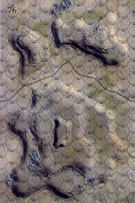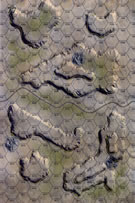|
I played the attacking DAK Battle Group and the ingenious and indefatigable Goosebrown led Task Force Stark in holding Djebel Chambi in this fun-filled 6-session play-through. Thankfully, we ignored the FOW, but used the smoke, consolidation, strategic movement, excess initiative, extended assault and tank riders optional rules. We also experimentally used the following five house rules: 1) Road Movement for Mechanized & Foot Units All FOOT & MECHANIZED units may move on roads at the rate of 1/2 a Movement Point (MP) per road hex, just like MOTORIZED units 2) Standard Movement for Mechanized Units All mechanized units may move through clear hexes at a movement cost of only 1 movement point (MP) per hex, instead of 1 1/2. Add one to this cost if moving up or down slopes hexes. 3) Dug In Units are Automatically in Limiting Terrain in Desert Games Unless prohibited by special scenario rules, ALL units that are dug-in on hill, slope or wadi & gully hexes are considered to be in limiting terrain and are spotted if enemy units approach to within 3 hexes, or 4 hexes for reconnaissance units – unless they fire or move. 4) Tank Leader Forward ObservationEfficient tank leaders (full strength only) may spot for ALL artillery & air strikes in accordance with the normal spotting rules (8.0, page 19). Just as in the case of leader units spotting, this action does not require an activation. Nonefficient tank leaders may also attempt to spot for ON BOARD ARTILLERY ONLY by throwing a single die per attempt to spot a target. This action does require an activation. They spot the intended target on a die roll of 4-6. 5) Anti-Tank (AT) Gunnery Enhancement Unless prohibited by special scenario rules, ALL dedicated, dug-in, entrenched, or town-occupying AT gun units including Self-Propelled AT guns may fire TWICE just like tanks in the standard rule set. For example: dug-in, German PaK 36 (37mm); PaK 38 (50mm); or British 2-pdr and 6-pdr towed AT gun platoons would therefore be able to fire TWO times in either AT fire or OPFIRE.
The initial session (game turn 1 & part of 2) featured an near-immediate German movement-to-contact on the hilltop of the 60-meter Djebel Chambi in two separate prongs on both the north and south flanks of the dug-in American positions that were – wisely placed – on the reverse slope. The supporting German 88mm gun platoon got off only two shots before being destroyed by accurate OBA fire. Only a single step of M-4 Sherman tanks was eliminated before the evil AT crew found themselves suddenly wandering in Valhalla. Fortunately, the Afrika Korps’ favorite mascot, Laszlo the Landser snail was unhurt in the heavy artillery barrage and proceeded to lay a glow-in-the dark, slime trail to guide the follow on Italian infantry battalion in their right flank movement-to-contact across the hilly north portion of Map 76. By the end of our first session, casualties stood at 11 steps lost for the defending Americans, and 5 for the attacking Axis force. This included the destruction of a section of an overeager Pz-IIIH tank platoon that ventured too close to an aroused, US engineer platoon that directed a “cold steel” close assault on their forward position.
The second session (the balance of game turn 2, plus turn 3) was a bit less costly for both sides and the Italians seized the initiative in the north by moving aggressively into firing range of the US defensive positions atop the 40-meter hill in the NE corner of Map 76. In the center on Djebel Chambi, the Germans slowly advanced into decisive close assaults on both flanks of the American position on the reverse slope of the summit, having success in both close assaults. The US force on the south edge of the summit broke and fled. Further south, a mixed Axis armored probe began making its way west across the south margin of the battle map. By the end of the session, casualties stood at 12 steps lost for the defending Americans, and 8 for the Axis attackers. A combined NINE, futile combat 7-die rolls were thrown.
The 3rd session (game turn 4) was another relatively costly one for the Americans with loss of an additional 3 steps, while the Germans lost another one. This was a longish turn that was interrupted by internet-related glitches while the contending forces were locked in a series of close range firefights and fiercely-contested close assaults on both the NE hill on Map 76, and also on the summit of Djebel Chambi. US step losses were at 15 by the end of this session, which fulfilled one of the German side’s 3 victory objectives. Highlights included the elimination of a pesky American M-6 AT portee, as well as another step of Sherman tanks on the margins of Djebel Chambi. In the north, the broad-front Italian attack was temporarily blunted by heavy defensive fire and OBA.
The fourth session (game turn 5 & part of 6) was characterized by continued fighting atop the Djebel Chambi with the American side still hanging on in a single hex by their fingernails (76-0611). Casualties included 6 more American steps of mixed arms and a platoon of Italian M-14/41 tanks. In the north, the Italians continued to press forward uphill supported by heavy mortar fire and OBA. They managed to clear one of the contested 40-meter summit hexes (74-0404) on the northern hill mass. Other highlights included a plague of a combined EIGHT combat 7-die rolls! When we quit for the night without finishing game turn 6: US step losses were 21, and the Axis had lost 15.
The 5th session (game turns half of 6, plus 7-8) was a grim one for the defending American side with costly fire fights and close assaults on Djebel Chambi in the center, and also the Italian-led, close-range fight atop the northern 40-meter hill. The American Commander and a single platoon of riflemen held on in hex 74-0404, blocking the Axis from capturing all 5 hexes needed to secure the summit of Djebel Chambi. Another section of Sherman tanks was eliminated by long-range Italian AT fire in the south at the end of turn 6, and a scuttling Pz-II light tank platoon was able to exit the west edge of the board to credit the first 4 Axis victory points. These tidings inspired Corporal Laszlo, the German’s pet snail, to lay down another extra-thick slime trail across the German Mortar position. At the end of game turn 8: US step losses were 31, and the Axis had lost 16, causing the Axis initiative level to fall to a 2. Surprisingly, only a combined 2 combat 7-die rolls were thrown in this session.
The sixth session (game turns 9-10) was a nightmarish one for the defending Americans with another 8 steps lost, to 0 for the attacking Germans. A great deal of close range action on both Chambi and the northern 40-meter hill ensued, mostly with negative results for the defenders. By the middle of game turn 10, all but one hex of Djebel Chambi was in Axis control, more than 15 steps of the US force had been eliminated (40), and 6 of the required steps of Axis units had already exited the west edge of the battle map – with 8 more within easy exit range in the next turn. By mutual agreement the American side conceded at the end of game turn, resulting in a decisive German victory. Corporal Laszlo proudly allowed the Americans the honors of war.
I give this slightly unbalanced, but very fun to play - as the Boche - scenario a 4. All 5 of the experimental house rules worked well in this scenario.
|







 AAAD032
AAAD032 















































